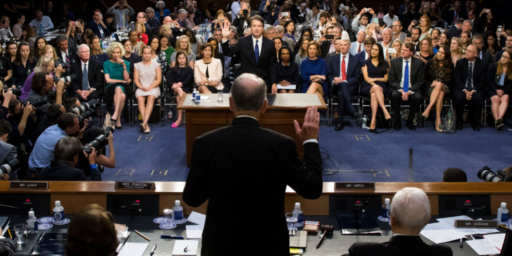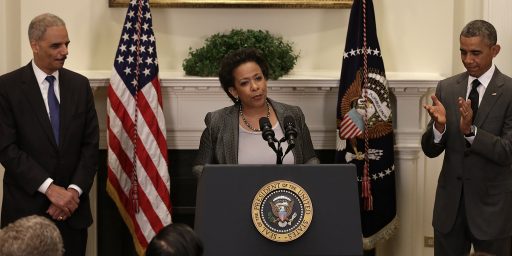Don’t Forget the Blue Slip Process
As significant as reform to the floor vote aspect of the Senate confirmation process undoubtedly is, it is worth remebering that opportunities for blocking nominations have hardly been removed. via the NYT: Despite Filibuster Limits, a Door Remains Open to Block Judge Nominees:
The new Senate rule clears the way for eight appeals court nominees who have already had confirmation hearings to win approval with simple majority votes, including three on the powerful Court of Appeals for the District of Columbia Circuit, which reviews federal policies and regulations. But it left unchanged the Senate’s “blue slip” custom, which allows senators to block nominees to judgeships associated with their states.
[…]
Any change to the blue slip rule would be up to the chairman of the Senate Judiciary Committee, Patrick J. Leahy, Democrat of Vermont. So far, however, he has enforced the rule broadly, even blocking a Kansas nominee to a federal appeals court because both Kansas senators changed their minds after clearing the nominee.
Sheldon Goldman, a political science professor at the University of Massachusetts, Amherst, said that if Republican senators used the blue slip rule to “gum up the works” and Mr. Leahy decided to allow confirmation hearings without their approval, Mr. Obama — and future presidents — would be freer to appoint more ideologically outspoken judges across the country.
After the vote to change the filibuster rule, Mr. Leahy reiterated his support for the blue slip rule. Still, he also said he could change his mind if it were abused — without defining “abuse.”
“I assume no one will abuse the blue slip process like some have abused the use of the filibuster to block judicial nominees on the floor of the Senate,” he said in a statement. “As long as the blue slip process is not being abused by home-state senators, then I will see no reason to change that tradition.”
The blue slip process allows Senators to effectively veto nominees from their states. A CRS report on the procedure is as follows:
One way in which senatorial courtesy has manifested itself is something called the “blue slip.” This is a device used by the Senate Judiciary Committee to communicate with the home-state Senators about a nomination to the U.S. courts of appeal or district courts, or to be a U.S. marshal or U.S. attorney. When a nominee is referred to the committee, the committee sends a letter (typically on light blue paper) asking the two home-state Senators to take a position on the nomination. The Senators check off the appropriate box on the sheet—either approve, disapprove or no position—and return the paper to the Judiciary Committee.
The blue slip process is used only by the Senate Judiciary Committee—no other Senate committee uses it for other kinds of nominations. The practice of using blue slips dates back to at least 1917.
At a minimum this is worth noting because it underscores that even with filibuster reform, the majority party hardly has unbridled confirmation powers. it is very much a chamber that is biased towards minority interests.






Yeah, that’s the reason I’ve been puzzled at the joy/furor over the Reid Rule. Very little has actually been accomplished other than to raise the temperature of the discussion.
What caused this? In other words, were there specific disappointments around 1917 that precipitated the blue slip rule?
@rudderpedals:
Could have been the Brandeis confirmation battle in 1916.